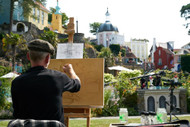EXCLUSIVE INTERVIEW: THE WINNER OF SKY ARTS LANDSCAPE ARTIST OF THE YEAR SERIES 8
2nd Mar 2023
The Sky Arts Landscape Artist of the Year Series 8 has been announced! After closely watching 48 artists and a plethora of wildcard artists painting spectacular scenes across the UK, judges award-winning artist Tai Shan Schierenberg, independent curator Kathleen Soriano, and art historian Kate Bryan have selected their winner. The deserving artist won a £10,000 commission for Royal Museums Greenwich to create a work celebrating the Dutch fathers of seascape painting - the Van de Veldes, plus £500 of materials from Cass Art. We caught up with them to find out more about their experience on the show and discuss their work.
WARNING SPOILERS BELOW!
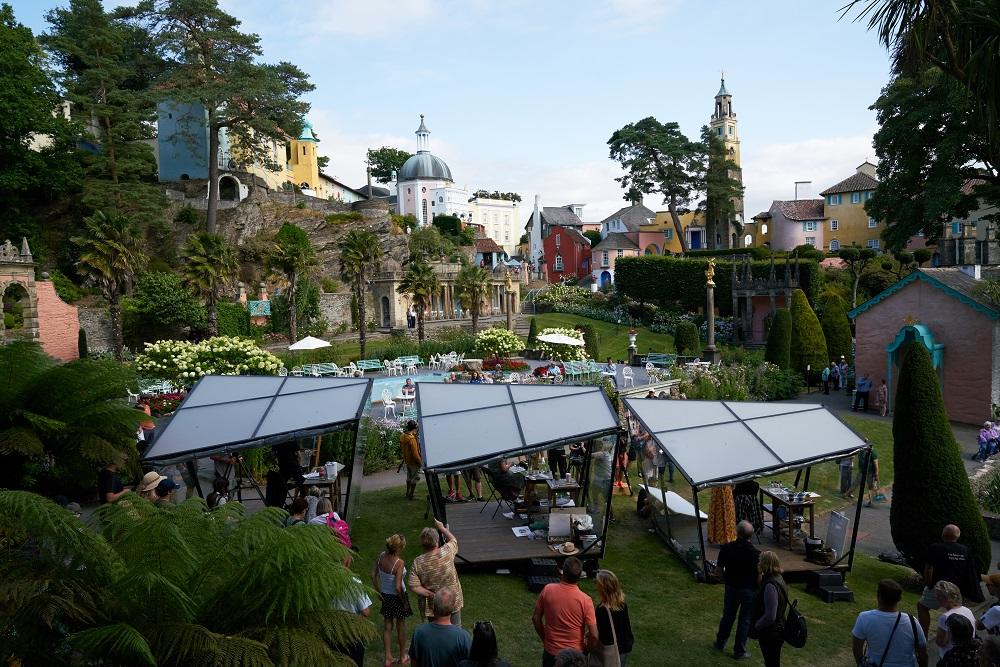
AND THE WINNER IS…
FINN CAMPBELL-NOTMAN!
Hi Finn! Huge congratulations on winning series 8 of Sky Arts Landscape Artist of the Year! How did you feel going into the final?
Hi everyone. Thank you very much indeed. Once the Semi-Final had taken place and Stefano, Helen and I had made it through we were whisked off to Dungeness a day or two later to sketch the locations there not knowing what we would be allocated. We then had about nine days to complete that painting before the final. I was actually without a permanent base so very quickly had to find somewhere to work. Luckily a friend had a studio I could work in in Bath, just off Queen Square and a spare room to stay while I did. It was a very happy time, knowing I’d made the final, it was high summer (the studio was boiling and wouldn’t you know it I got a nasty flu too) and I got to spend as much time with close friends as I have in many years. I then travelled up during the heatwave with another, my oldest mate and his son in their camper van up through Wales. We took a few days stopping in a few beautiful places along the way, climbed Pen Y Fan in the Brecon Beacons, dropped in at some friends in Lampeter – where in 38 degrees we swam, Aberystwyth where yet another great friend and family were visiting their mother, on through Machynlleth and finally arriving in Porthmadog the night before final. All of which is a way of saying that what the viewer sees on screen is the tip of the iceberg. I know both Stefano and Helen had crazy adventures on their way to. And the three of us, now firm friends were now more of a team than competing individuals which meant that we all felt we would do our best and be happy for each other whoever won.
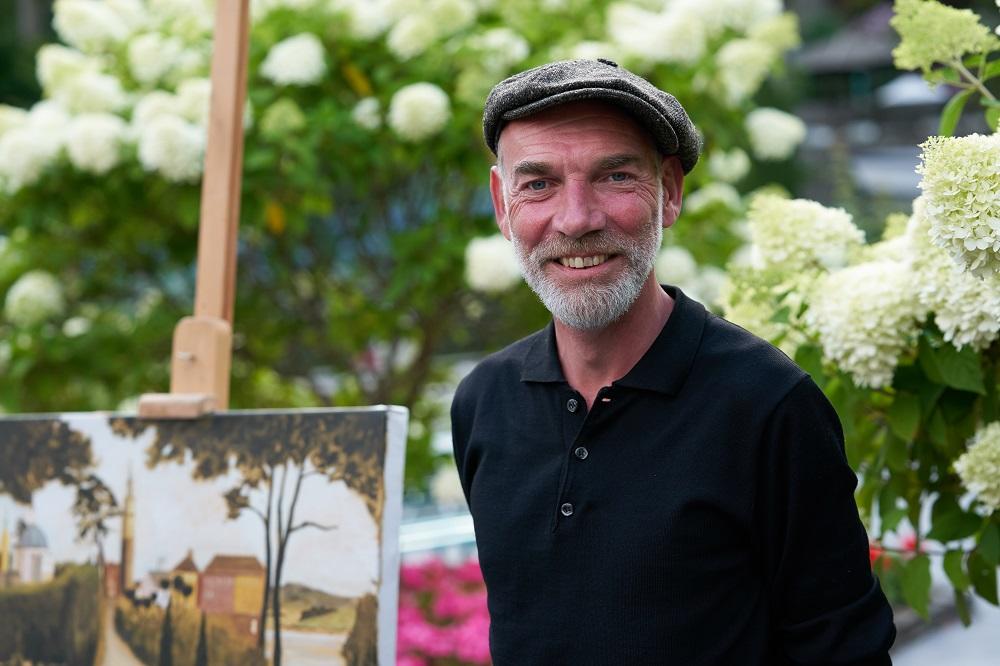
Finn at the final at Portmeirion
The final took place in Portmeirion in Wales, a fairy-tale tourist village inspired by the architecture of the Italian Riviera. Eclectic architectural styles, brightly painted, are surrounded by plants, topiary and sculptures. How did you decide what to focus on when there were so many options?
With great difficulty and very quickly as there was not much time to wander around, take it all in and settle on a composition. It was again a hot day, the village was open to the public too – and mid-afternoon was full. I knew the history of the place very well and indeed was a big fan of The Prisoner (the 1960’s TV series filmed and set in ‘The Village’ starring Patrick McGoohan) when it was re-shown in the early ‘90s – so much so that on a visit to Paris when doing my foundation I stumbled into Club No6 in the 6th Arrondissement wearing the uniform (boating shoes and blazer) without knowing it was there. Very fitting. So, now being in Portmeirion felt fated. Knowing that the final is judged on both the painting on the day and the painting completed prior took some of the pressure of the day off – which was needed because it was a complete overload: Portmeirion, on TV, painting against the clock, the stop-start nature of filming and all with the hubbub and commentary of the crowds while in the goldfish bowl of our pods.
For the painting itself I took the same approach as I had done for the other heats: not a direct transcription of a single view but selected elements which would add up to a strong compositional ‘stage’ (Portmeirion is exactly that) within which I might later decide/see some element that would perhaps indicate a story.
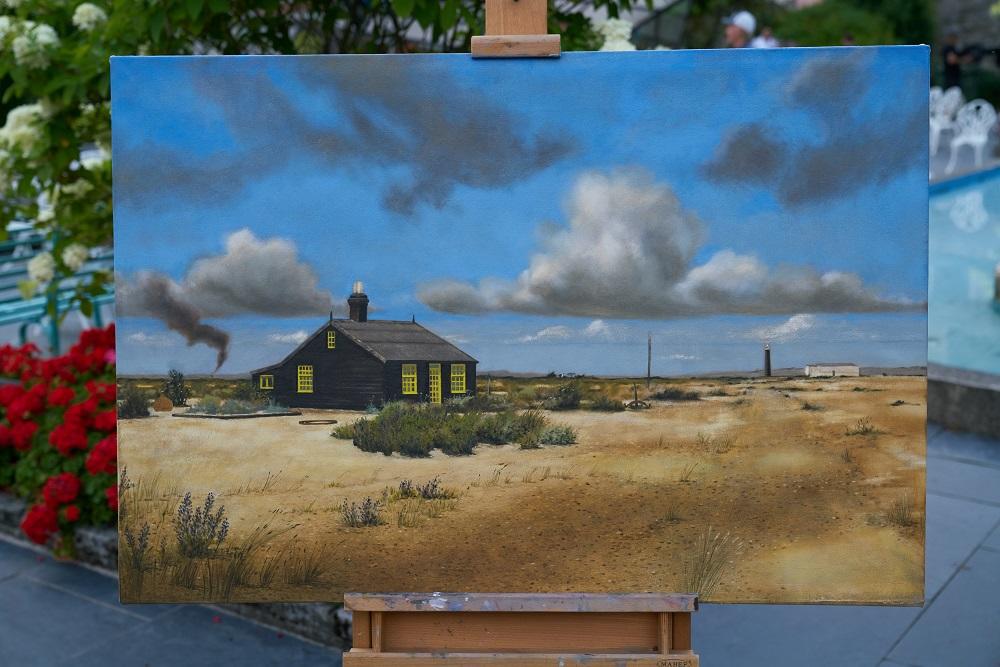
Finn’s commission of Dungeness
As part of the final, the three finalists were taken to Dungeness – a stark landscape with a pebbled beach and nuclear power stations looming in the distance. Each artist was asked to create a commission over the course of a week. Your commission focussed on Prospect cottage – former home of filmmaker Derek Jarman. Similarly to the semi-final when you captured a boat sailing by, you managed to capture a moment of movement – the Romney Hythe and Dymchurch railway ‘carrying a line of story’ across the image. How important is storytelling in your landscapes and how do you create stories in your work?
I loved Dungeness. I hadn’t been there since a small child but had watched all of Derek Jarman’s film and knew the story of Prospect Cottage. On the way there we were told we’d each be allocated a location within Dungeness. I actually hoped not to be allocated Prospect Cottage for what could one add to an icon: it is also a flat landscape, it was a cloudless morning and, once I had been allocated the cottage I was only allowed one view from across the road and not to enter the garden. I think I said at this point ‘well then, I’ll have to make sure this will be the painting of Prospect Cottage’.
Again I had to think on my feet and be decisive. Since I had two options: looking at the front of the cottage from either the left or right: and neither view had individually much to work with. As you can see on the winner's film the preparatory sketch I did took elements from left and right, near and far to create a good composition. That’s why that term is used: organising a picture is nearly always necessary and it’s rare, at least for me, that a single view makes for a good, well-composed painting. One of my aims is always for the finished painting to hold stillness and anticipation in equilibrium.
To answer your question directly: it’s odd, I don’t consciously ever think; ‘what’s the story here?’ or ‘what could the story be?’ or even about stories at all. Put it this way; it’s as if the story that the viewer might see in the finished work was always there and it’s in the process of painting that it reveals itself to me too. But I’m not trying to ‘read’ a landscape but perhaps trying to glean meaning from it. No that’s not quite it either. I’ve just completed a companion piece to the winner commission: same size, with similar themes happening it seems to me now.
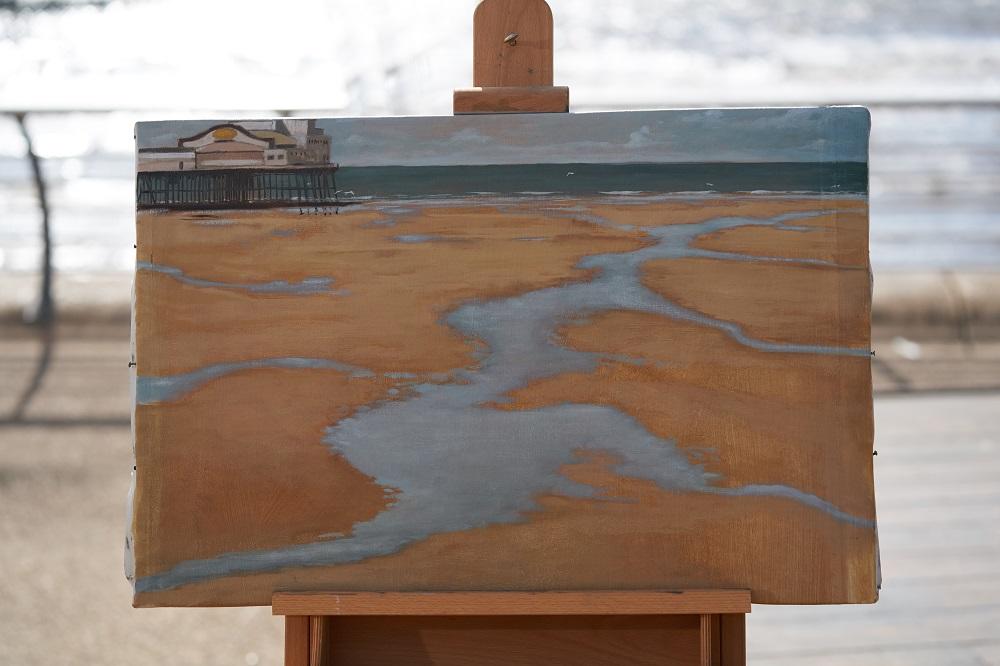
Finn’s winning painting of Blackpool beach and pier from Heat 1
Your compositions are well-considered, the eye is drawn in and travels across your paintings with ease, and there is a perfect balance of stillness and movement. The judges were also impressed by the sense of mood and atmosphere in all your works. How do you develop a strong composition in your works and what elements in your paintings are key to conveying mood?
I’ve often heard it said that an artist should never explain or write about their own work. I understand why and disagree. It’s been my practice always to do so because I too want to understand better my own work. How else does one improve and grow as an artist without reflecting on what one has previously made both by looking at it and, for me, to also write about it (i.e at a slight remove) and of course to then fold that into the next and the next. That’s to dispel the mistaken notion that all painting is inspiration and skilful execution. It is in part those things but it is also many other things, among them graft and reflection. I do spend a good amount of time composing but as a result of that reflection know not to fix things too rigidly either in my mind or on the page to allow for changes and the happenstance, to erase parts that are unharmonious, sometimes move things (and this happens both during composition and execution) because the mood that I evoke derives from that equilibrium. If something within the painting disrupts that then one has to be ruthless. In the Prospect Cottage piece, I erased the road entirely, the structure of the composition required that it go. And once it had that ineffable feeling was allowed room to breathe.
I would also say that the mood so many pick up in my work derived from this slightly odd conundrum (I’m still figuring it out btw): I want the viewer to see what’s in my head from my point of view, or rather, that the painting is the direct projection of it onto canvas. If I do this sufficiently well the painting has what the German writer Hans Belting calls the ‘Aura’ of a work of art. This I think, hope, is what is meant by my ‘mood’. Conversely one always must give room to and for the viewer to enter that ‘stage’. So that interaction between what I’ve set up and how that is experienced, perhaps triggers feelings or semi-memories that I think add up to the ‘story’ evoked in the viewers mind (rather than, as I say, an intended story).
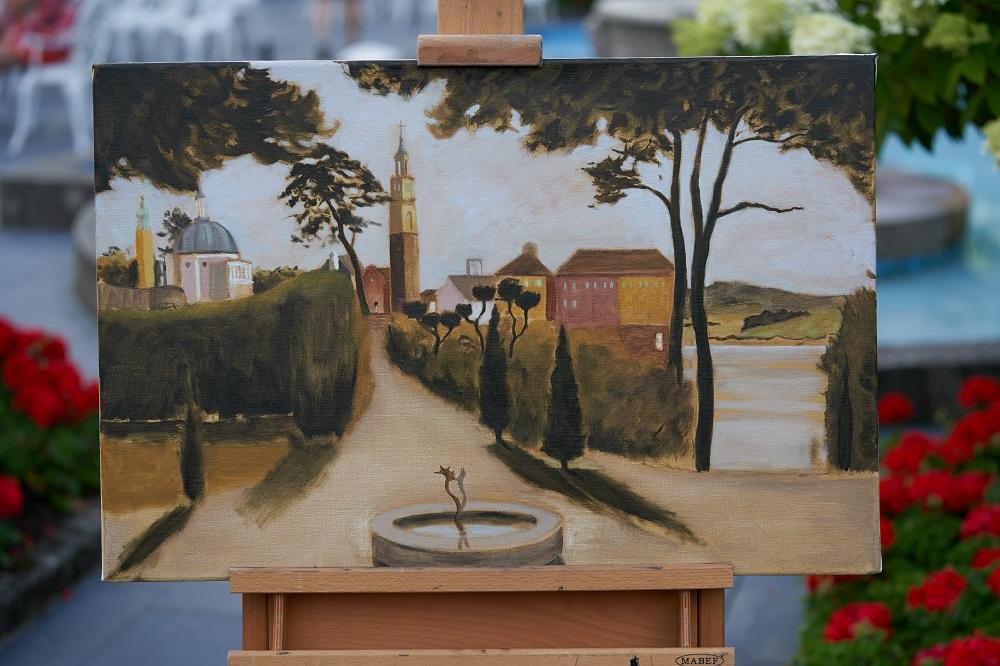
Finn’s winning painting from the Final at Portmeirion
Drawing, sketching and pen work were important to William van de Velde the elder who was an accomplished draftsman. When you returned from your travels around the Netherlands you also made many annotated sketches. How important are the preparatory sketches in your work and what decisions are you making in that process?
I made on location pencil sketches, a few oil sketches and on my return quite a few drawings.
All these were a way of trying to fold in the Van de Velde's work, that it be a maritime painting, that it included elements that were my reflections on some similarities in their life stories and mine. So a lot of that process is visualizing things that are perhaps non-visual, yet reference and are inspired by their work. For example, how to convey a sense of exile (both theirs from Holland and mine – something I address in the commissioned painting and a subsequent companion piece). Or how to take on the Van de Veldes and make a painting that is non-period specific (for what would be the point of painting a 17th century ship? Incidentally, we were possibly going to visit the Dutch Naval base in Den Helder but logistically could not and thus did not see contemporary and comparable vessels. All very tricky – indeed, it was a very tricky brief, very much open to interpretation but also an opportunity to follow in their slipstream.
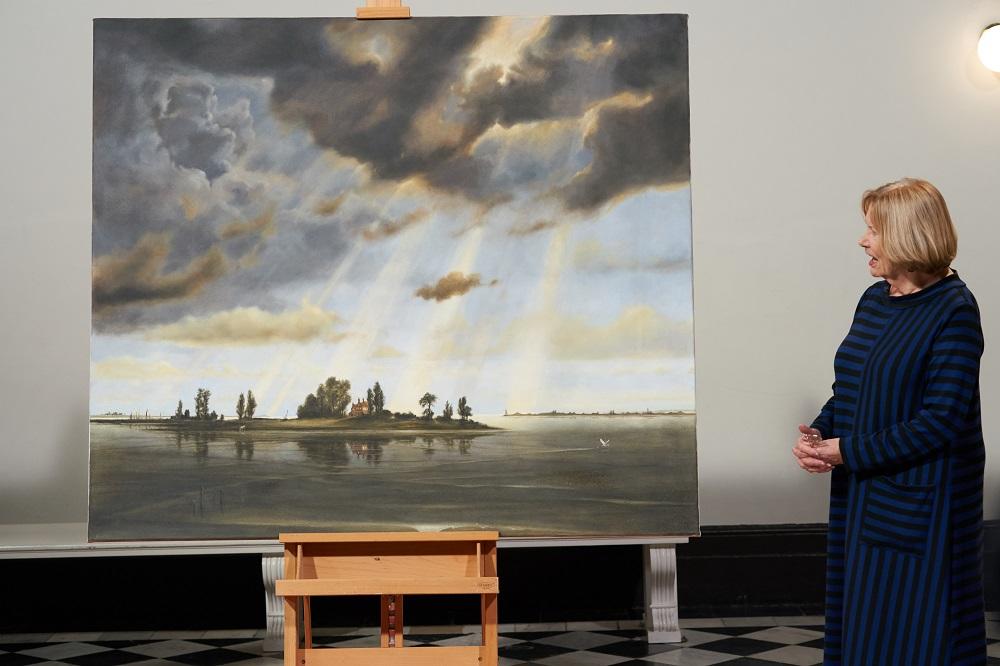
Final commission ‘Fail We May, Sail We Must’
Van de Velde the younger transformed the elder’s drawings into oil paintings – depicting atmosphere & emotion in billowing clouds and tumultuous waves. In your winning commission, the calm seas and skies you saw on your travels were slightly lacking, so you incorporated some local Devonshire seascapes into the piece to emulate the atmospheric works of the Van de Veldes. What was the biggest challenge when you got back to the studio in Devon after your travels?
My approach to landscape painting is that a painting is rarely, if ever a direct transcription from a single view, even those painted plein air. One composes and constructs, simplifies, rearranges and perhaps adds certain elements to create a picture. The finished painting is thus a record of a dialogue with both what is seen and what is reflected within, and what I want to transmit; between what is seen and what is felt.
The Van de Veldes paintings, their biographies, and the exhibition together form the external context and parameters within which this commissioned painting took shape. The title ‘Fail We May, Sail We Must’ quotes and refers to a tale told by an Irish fisherman to the now sadly deceased Andrew Weatherall. This phrase became his maxim for life. Every artist enters this realm of risk with the undertaking of each new painting. When the Van de Veldes were compelled to leave Holland in 1672 they too embarked with this uncertainty.
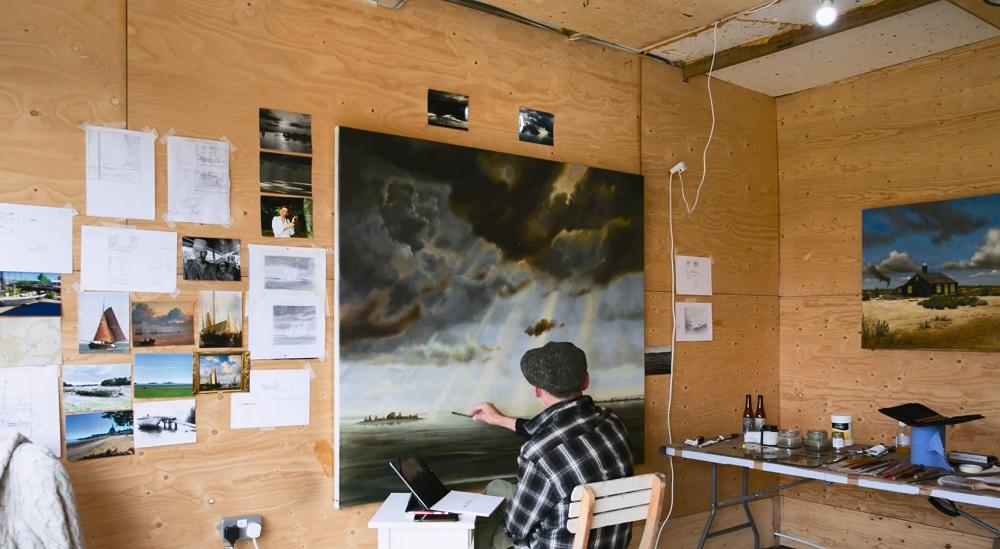
Finn in the studio
I grew up on the Norfolk Broads and for a few years we lived on a boat called ‘The Broadland Belle’. My step-father (Peter Bearman) was both a merchant seaman and a landscape painter. He was a kind of East-Anglian Peredvizhniki; setting off with easel and paints before dawn from wherever we had moored, returning at dusk. Home from a voyage he would bring both tall tales and the occasional gift from abroad. He was to me, however, very much the archetypal Dutch Uncle.
In 2004 as my major final work at the RCA I made a film with Peter as the sole protagonist. The film shows Peter rowing along a river in Norfolk towards a ruined mill. The first half looks toward him and upriver from the stern as he rows towards this mill, where we turn. The second half looks down river from the bow as we are rowed away from the mill. The film’s title ‘Stendhal’s Mirror’ refers to the famous passage in 'The Red and the Black' in which the author states that ‘a novel is a mirror carried along road’. That is to say a novel/artwork should be true to life as it is rather than idealised.
But each of us carries within a multitude of inner landscapes and for me, these are the mirrors in which the external is reflected. This I think is the reason my work provokes particular responses: because my imagery is both retrospective and prospective: since my work simultaneously looks within and without upon a prospect the works are a record of both intramission and extramission and this process creates what Hans Belting calls the ‘aura’ of a painting and what could be termed irreality.
This then is the paradox of Stendhal’s Mirror: a reflection is not reality and if that mirror is the interior mirror the resulting work is rendered irreal. The contemporary is thus instantly rendered historical and vice versa: the historical becomes and is present. With this background the commission was for me fitting, ironic and poignant. The completed painting ‘Fail We May, Sail We Must’ is the record of a set of personal and historical, pictorial and conceptual paradoxes held in equilibrium within a single frame. I’ll unpack a few of these dichotomies as they are depicted:
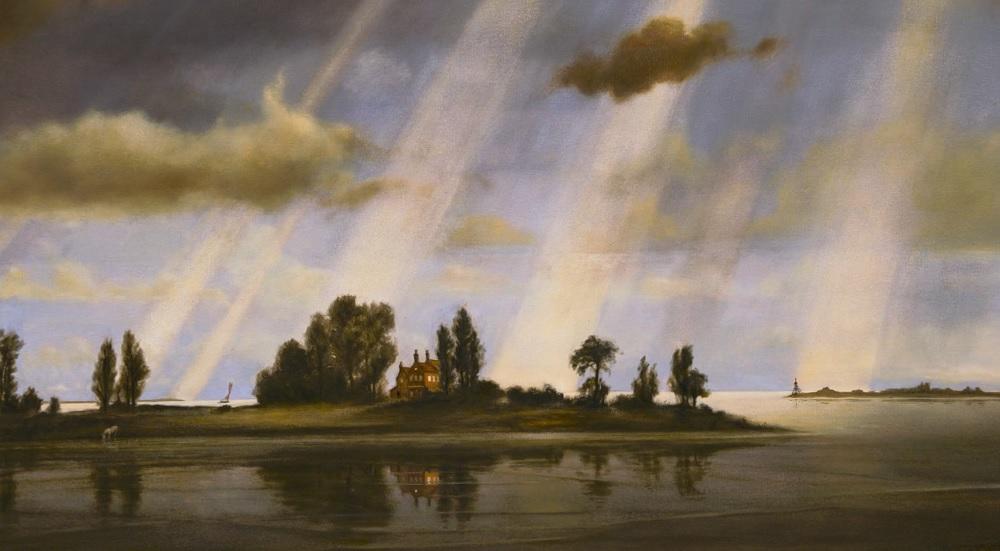
Final commission ‘Fail We May, Sail We Must’ (detail)
Home and Exile / Place and Displacement
Much like the Van de Veldes I too have been exiled and similarly to them this was due to a combination of accepting opportunities overseas and being forced from the places that we called home. In my case home was and remains both a concept and an actual place an old house surrounded by nature. To be far from home in distance and in time and yet to always carry this within you means that to be exiled, to travel is to live forever temporarily wherever you may find yourself. It is a solace and unsettling. The landscapes of both Holland and the Norfolk Broads exist between huge skies and ever present water; the land an ephemeral sliver suspended between the two existing as if a kind of mirage, a water-land. The island depicted has upon it a house, and this is Ludham Manor where I grew up and had to leave. Together they stand for the idea of home – mine and the Van de Veldes'. We see this image of home in the painting from across a body of water and beyond that to the open sea.
Proximity and Distance / Time and Space
The viewer of ‘Fail We May, Sail We Must’ is placed by the organization of the pictorial elements (in the same way Van de Velde Younger places his viewer) within the scene such that the viewer is implicated in and becomes a protagonist within the painting. The viewer looks from the nearby lapping wave to the horizon, looks from the present through the past (the island/vessel from which another vessel has departed) an on to the future. This is all seen as if in a glimpse or perhaps a memory; a recording of something that both happened and is happening so while the painting has a stillness it is held momentarily on a threshold.
Poise and Counterpoise
The calm reflective surface of the water is counterpoised by the passing storm clouds. There is a clarity and freshness to the air; we can see past the sunbeams into the far horizon yet the opacity of the water counter-intuitively grounds the viewer. In a sense, my paintings are orchestrations of all the elements within the frame and I know if a painting is succeeding when it begins to feel harmonious. Nevertheless, there can be, as here, elements of discordance but they must always function as counterpoise underscoring the overall harmony. The seltsamer stimmung (strange mood/atmosphere) of my work derives directly from conceptually and thematically resolving within my pictorial grammar just enough to leave the viewer wanting to know more; to both pose questions and to reveal some, but not all, the answers. ‘Fail We May, Sail We Must’ is then a kind of paracosm: one that exists halfway between the world of the Van de Veldes' and mine.
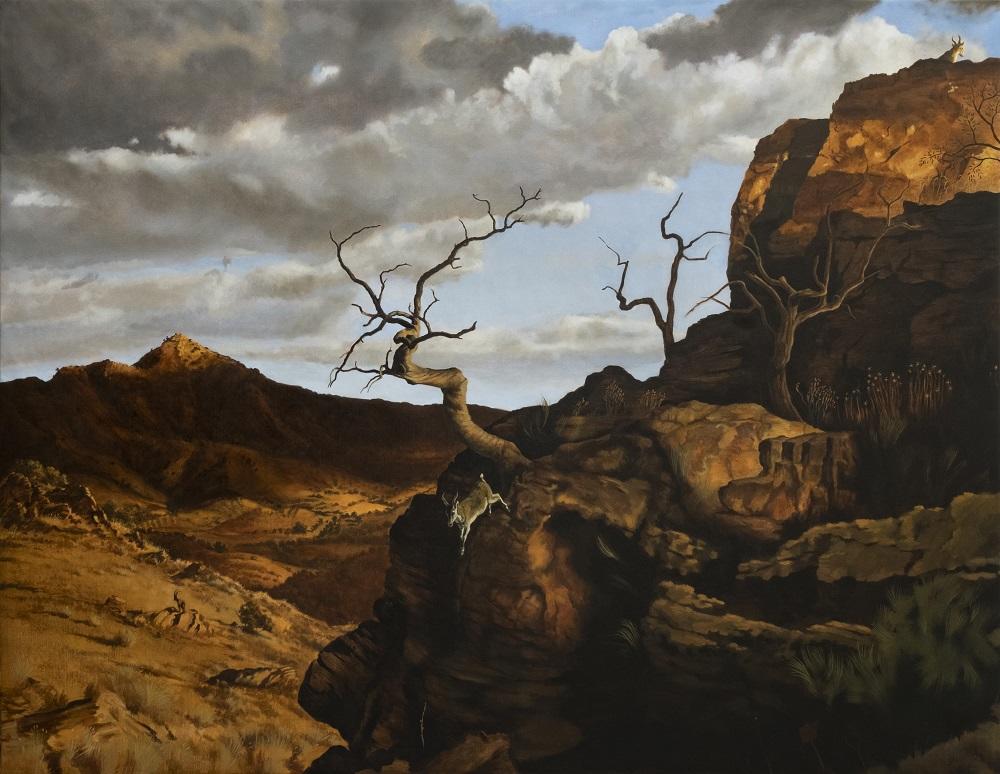
Companion painting to ‘Fail We May, Sail We Must’
The judges often referenced your warm and romantic colour palette. Can you walk us through the materials you used in your final commission and some of your must-have colours?
The stretcher is aged ash wood with finger joints (unglued). The canvas is 300gsm unbleached cotton. The ground is three coats of gesso primer. The painted surface has these layers: a charcoal powder drawing sealed with casein, several glazed layers using Roberson’s quick drying glazing medium, and then varying levels of glaze and opaque oil. I work both ways: that is; laying on and scrubbing back – this derives from my drawing methods. My palette is somewhere between that of the north/Norfolk and the south/Spain. Tonal but warmer than the northern one. I think that adds to the ‘romance’. Oil colours from Blockx, Sennelier, Winsor & Newton, Michael Harding and Talens. Brushes include many, from cheap household decorating brushes to a few sable for details.
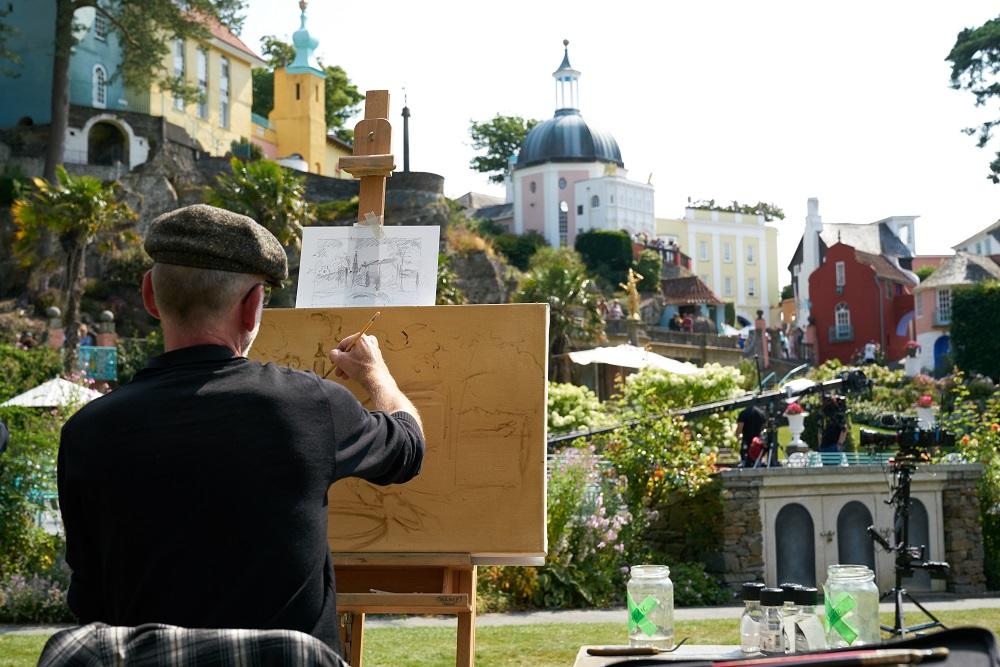
Finn painting on location at the final at Portmeirion
What advice would you give to artists considering applying for the next series? Do you have any tips or plein air painters?
I would say, enter with all your heart. If you do get selected just do your best while ignoring the ‘event’, the kerfuffle and the process. After all it’s painting just in a different context. I’m not really a plein air painter, and indeed the format really suits practiced plein air and impressionistic painters best: it’s outside and in one day so if I can enter and succeed then there is hope for everyone.
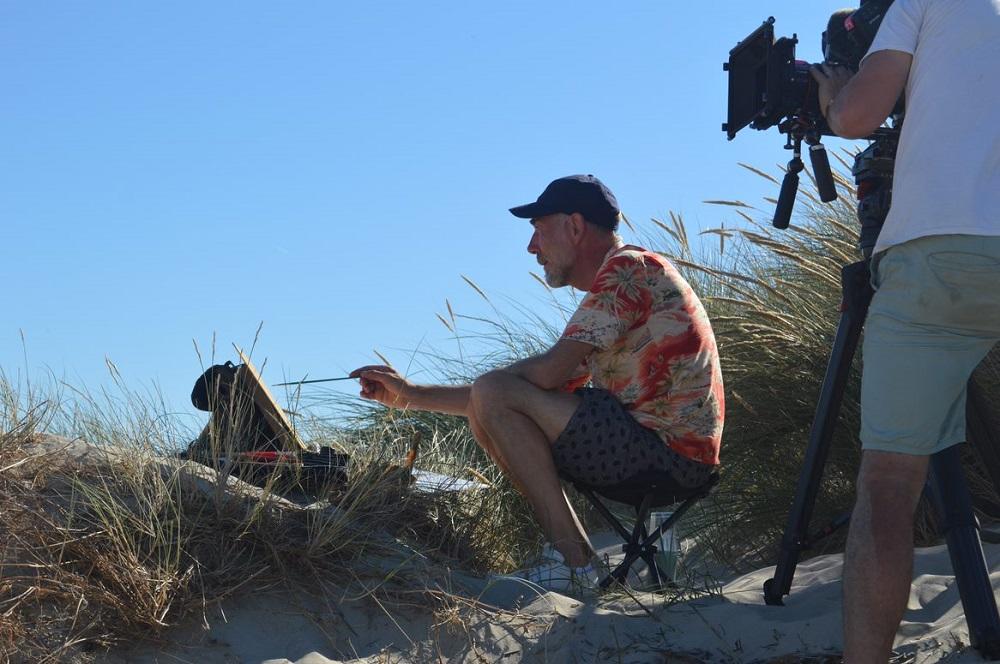
Finn painting on location in Devon
Now your winning commission is complete, what’s next for you?
I’ve always felt pretty much an outsider, never quite part of the artworld (whatever that means). However entering LAOTY and winning has, as I say on screen, felt like a kind of validation and perhaps a breakthrough. I don’t really fit in the contemporary art scene (perceived as too ‘traditional’) nor am I traditional enough for Cork St (not impressionistic or loose enough and definitely not dead) and I’m no longer an illustrator (I never really truly was - too ‘fine art’, too ambiguous). Perhaps then, I’ve yet to find my niche or rather my niche has as yet not found me. I hope it does now in whatever form.
Winning LAOTY is a real shot in the arm, and I hope not a mere booster jab requiring another in a few months. I was pleasantly surprised to feel entirely at ease on camera during the making of the winner’s film (but then who wouldn’t enjoy the spotlight on one’s work after a lifetime of obscurity) so I’d love to do more things on screen. I haven’t really taught much but all who know me say I should. I have several strong bodies of work ready to show so finding appropriate opportunities to do that is a priority. I’d love to spend a good chunk of time in the British countryside, discovering new places as I did during LAOTY while working on commissions. But if none of this transpires I shall continue to, as I always do, try to make the next painting the best one so far. And if all these things happen then it’ll have taken a lifetime to become an overnight success.
Thanks Finn! See more of Finn’s work at ficano.art or @finn_campbell_notman_art on Instagram.
Feeling inspired?
If you've admired the works on the series, visit skyartsartistoftheyear.tv where selected artworks from all nine series, as well as from Sky Arts Portrait Artist of The Year, are now available to buy.
Read our interviews with all of the Series 8 Heat Winners and Wildcard artists on the Cass Art blog here.
If you think you have what it takes to be the next Sky Arts Landscape Artist of the Year, entries for Series 9 close at midday on Friday 28th April 2023. Find out more and apply at skyartsartistoftheyear.tv/landscape. Good luck!

